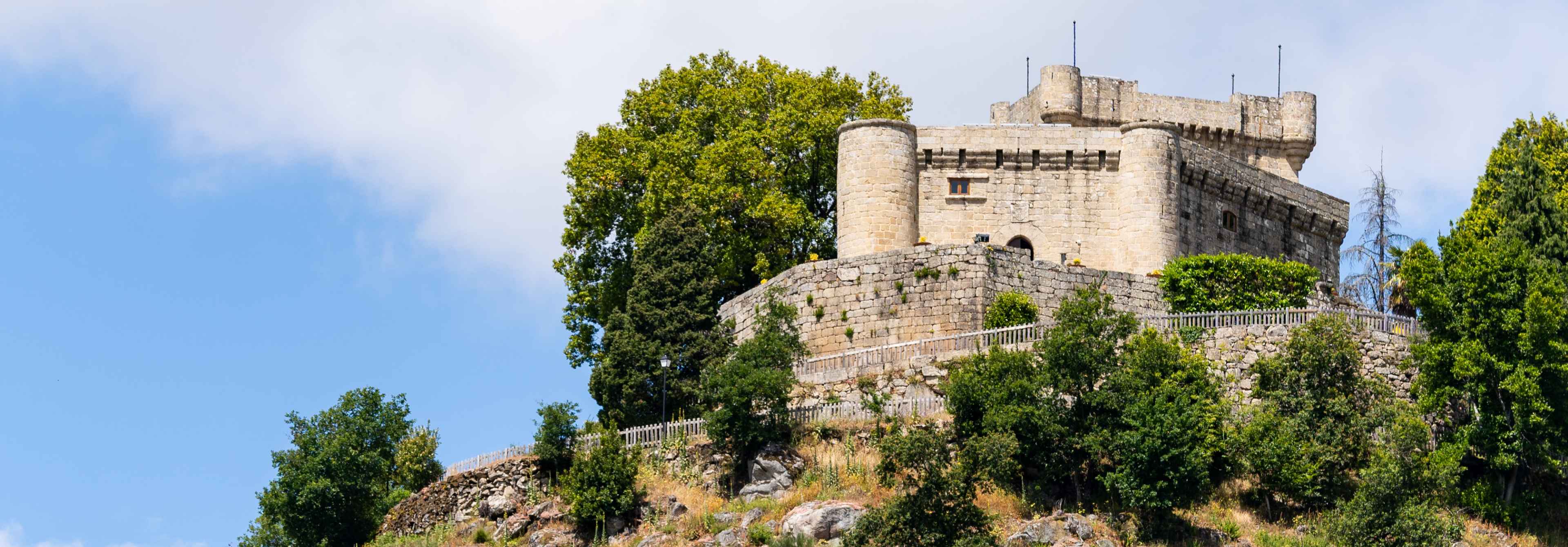ALEJO CARRERA MUÑOZ, THE LAST LORD OF SOBROSO
He was born on the 17th of February 1893, in Vilasobroso —then called San Martín de Portela—, 3 km away from Mondariz-Balneario. His father, Manuel E. Carrera, was from Ponteareas, and his mother, Rosa Muñoz Vázquez was born in Vilasobroso.
His childhood was closely intertwined with the ruins of Sobroso Castle. His father, who sometimes acted as his instructor, instilled strict physical and moral discipline in him. Every morning, they would climb towards the castle and past it, through Mount Landín. There, they would sit next to a fountain to have breakfast, and Alejo would listen to his father's lessons.
Occasionally, they would spend time among the rocks of Sobroso, and right there his father would tell him the legends and stories surrounding the castle and its relevance during the Middle Ages in Galicia.
When he was 11 years old, he started working on his own initiative as a mechanical sawmill operator. His workdays were 11 to 12 hours long, earning only one peseta per day. It was his father who suggested this job to dissuade him from dropping out of school. Nevertheless, it did not work. The youngster worked there for more than a year, and when he was 12 he got a job as a library assistant at Peinador's Gran Hotel, at the Mondariz spa. In the summers of 1906 and 1907, he went back to work as a librarian, and used this time to read profusely.
On the pretext that he had a relative living in Lisbon, he got his father's permission to move to the Portuguese capital on the 16th of October 1907, when he was only 14 years old.
There, he carried out administrative work, writing letters and private documents for the inhabitants of the Galician colony in Lisbon, and started his work in journalism collaborating with "El Tea" newspaper, published in Ponteareas, when he was 15 years old. In 1911, when he was 18, he published an article about Sobroso Castle in this newspaper on the occasion of the visit of several British journalists, showing a lot of enthusiasm on the restoration of the building.
On the 20th of March 1910, he returns by boat to Galicia and stays with his father, who was almost 80 years old at that time. During this stay, the founder of the spa, Enrique Peinador Vela, offered Alejo to spend some time at the Gran Hotel and take charge of the library, which he was pleased to accept.
He travels to Madrid on September of that same year, keen on getting to know the capital, and accepting there a position as secretary of the Baron of Sacro Lirio. He returned to Vilasobroso in 1911, to spend some time there, and then went back to Lisbon, where he settled for good.
During the 25 years that would follow, he carried out his life's most intense work as a correspondent for newspapers and telegraphic agencies. In the performance of his job, he took up with artists, journalists and writers in official centres, embassies and social gatherings. He was invited to all kinds of events and trips, and overall, he increasingly gained recognition.
He married Adelaida Amaral Ferreira on the 31st of July 1919, and the only child from this marriage was Zita Teresa Carrera Ferreira, born on the 17th of June 1920.
On the 26th of May 1916, when he was 23 years old, he was appointed associate partner of the Royal Galician Academy of Language, when Manuel Murguía was its president, and Eugenio Carrel was the secretary.
He founded the Portuguese division of the telegraphic agency Agência Radio, and at the same time, set up a successful commecial entity distributing books, newspapers and magazines.
He worked as a correspondant for newspapers such as “El Mundo”, “El Imparcial”, “El Pueblo Gallego”, “El Sol” or “El faro de Vigo”, and founded the republican newspaper “El Sobroso”, published for three consecutive years, from 1931 to 1933. He had a very productive journalistic career that earned him merits.
He also forged an interesting carreer in politics, as in 1924 he became the first suffragan mayor of the Vilasobroso minor local entity, renamed San Martiño de Portela at his request. He joined the Radical Republican Party, becoming the first republican mayor of Mondariz in 1931, although he was dismissed from his position in May of that same year.
He bought Sobroso Castle in 1923 and started the restoration work on it with the help of master stonemasons from the district. This huge project would become his life's work.
He took the decision to buy it around 1920, when he was 27 years old. It was at that moment that he started negotiating with its former owner, the Count of Torrecedeira. Negotiations stretched over more than two years until the count finally agreed to sell it for 5,000 pesetas on August 28th, 1923.
And just like that, an emerging journalist was able to buy a whole castle, solely with his earnings as a correspondent.
From that moment, Sobroso became Alejo's personal obsession in which he invested large sums of money. The land surrounding the castle was enlarged as he bought more than 250 adjoining plots with a total extension of around 300,000 square metres and replanted more than 200,000 different forest species. He also had a one-and-a-half-kilometre-long road built, as well as a bridge to allow access to the castle by car.





